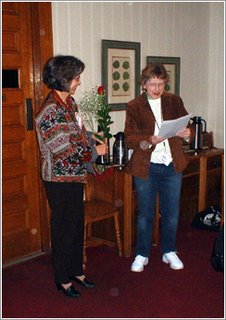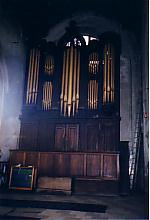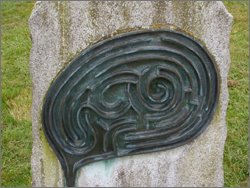
Frithewald, King of the East Angles and first Christian ruler of his tribe, was in constant fear of being attacked by marauding Danes whose notoriety preceded them. They were known for their brutal attacks, sparing no life regardless of age or gender. He and his wife Wilaburga were fearful that their home would be pillaged and their beautiful young daughter, Osyth, would be kidnapped.
Frithewald and Wilaburga were so concerned for Osyth’s safety they sent her away to the relative security of the county of Warwickshire. Her personal care and spiritual guidance were placed in the hands of Abbess St. Moden, who ran a strict priory but provided love and care of her novices.
One day, Abbess St. Moden sent young Osyth on an important mission to visit a nearby priory to collect a precious book from the Abbess St. Edith, sister of King Alfred. Osyth set off pleased that she had been given such a significant task. After her visit to the neighboring priory, Osyth carefully carried away the book, mindful of her duties to guard its safety. However, on her return journey, the weather worsened and as she crossed a bridge, she was swept into the swollen torrents of the fast-moving river.
Three days passed without St. Moden hearing from Osyth so she decided to visit St. Edith herself. St. Edith told the Abbess that Osyth had collected the book as instructed and, after some brief refreshment, had set off on her return trip that same day. Prior to knowing that Osyth was missing, St. Edith had a vision in which an angel told her to visit the river. Believing this to be an omen, the two women set out on their journey fearing the worst, but they found Osyth sitting quietly by the river with the precious book unharmed in her hands.
Another legend concerns Osyth’s adult life. When she became a grown woman, her parents betrothed her to Sighere, King of the East Saxons. She was an obedient girl and would not defy their wishes and so agreed to marry Sighere. On the morning of the wedding, Osyth’s father, the groom and the men of the wedding party noticed a white deer in a clearing of the woods. They took off in pursuit of the deer leaving Osyth and the womenfolk alone. As she sat quietly awaiting her fate, Osyth decided the life of a nun was preferable to becoming Queen of the East Saxons (later to be known as Essex) and she defied her parents’ wishes and stole quietly away to a nearby convent where she quickly “took the veil.” Sighere was devastated when he returned from the hunt but he loved Osyth and only wanted her happiness, so he built her a priory on a quiet inlet on the coast. It was not long before she was ministering to several young novices of her own and pursuing her dream of serving Christ, but the location of the priory proved fateful.
In 653, on a warm summer’s day, a band of Viking pirates led by Hubba and Inguar swept into the village and came upon Osyth’s convent. The Vikings terrorized the nuns but Osyth stood her ground and proclaimed her faith in God. The Viking, Hubba, ordered Osyth to recant her faith and accept his pagan god. She would not, so the infuriated Viking ordered a warrior to severe her head. The order was carried out and according to local legend, after Osyth had been decapitated she gently bent down, picked up her head and walked to the chapel. Once at the chapel door, her bloodied hand pushed it open and she fell dead upon the floor.
Frithewald and Wilaburga were so concerned for Osyth’s safety they sent her away to the relative security of the county of Warwickshire. Her personal care and spiritual guidance were placed in the hands of Abbess St. Moden, who ran a strict priory but provided love and care of her novices.
One day, Abbess St. Moden sent young Osyth on an important mission to visit a nearby priory to collect a precious book from the Abbess St. Edith, sister of King Alfred. Osyth set off pleased that she had been given such a significant task. After her visit to the neighboring priory, Osyth carefully carried away the book, mindful of her duties to guard its safety. However, on her return journey, the weather worsened and as she crossed a bridge, she was swept into the swollen torrents of the fast-moving river.
Three days passed without St. Moden hearing from Osyth so she decided to visit St. Edith herself. St. Edith told the Abbess that Osyth had collected the book as instructed and, after some brief refreshment, had set off on her return trip that same day. Prior to knowing that Osyth was missing, St. Edith had a vision in which an angel told her to visit the river. Believing this to be an omen, the two women set out on their journey fearing the worst, but they found Osyth sitting quietly by the river with the precious book unharmed in her hands.
Another legend concerns Osyth’s adult life. When she became a grown woman, her parents betrothed her to Sighere, King of the East Saxons. She was an obedient girl and would not defy their wishes and so agreed to marry Sighere. On the morning of the wedding, Osyth’s father, the groom and the men of the wedding party noticed a white deer in a clearing of the woods. They took off in pursuit of the deer leaving Osyth and the womenfolk alone. As she sat quietly awaiting her fate, Osyth decided the life of a nun was preferable to becoming Queen of the East Saxons (later to be known as Essex) and she defied her parents’ wishes and stole quietly away to a nearby convent where she quickly “took the veil.” Sighere was devastated when he returned from the hunt but he loved Osyth and only wanted her happiness, so he built her a priory on a quiet inlet on the coast. It was not long before she was ministering to several young novices of her own and pursuing her dream of serving Christ, but the location of the priory proved fateful.
In 653, on a warm summer’s day, a band of Viking pirates led by Hubba and Inguar swept into the village and came upon Osyth’s convent. The Vikings terrorized the nuns but Osyth stood her ground and proclaimed her faith in God. The Viking, Hubba, ordered Osyth to recant her faith and accept his pagan god. She would not, so the infuriated Viking ordered a warrior to severe her head. The order was carried out and according to local legend, after Osyth had been decapitated she gently bent down, picked up her head and walked to the chapel. Once at the chapel door, her bloodied hand pushed it open and she fell dead upon the floor.
An Excerpt from Extraordinary Places ... Close to London


















